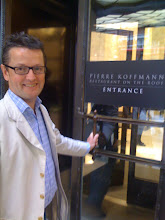It was the 150th birthday of fish and chips the other day and I was in Aldeburgh on the North Sea coast and decided to mark the occasion with the bag of "rock 'n' chips" shown above. As an insititution, fish and chips was voted in a recent poll as Britain's most loved (knocking the Queen into second place).
Britain's first fish and chip shop opened in London in 1860. It is not clear exactly how and when the battered fish first met the deep fried potato but historians interested in that sort of thing often cite Jews in the east end of London selling (cold) fried fish in the street as a precursor. There was also a tradition of potatoes as street food but these were baked and not fried.
Manchester and Leeds make claims for inventing fish and chips as we know it today and indeed fish and chips is arguably more popular up north than down south. Many Scots would claim fish and chips as the Scottish national dish, rivalling haggis (though in Scotland you ask for a "fish supper" when ordering fish and chips, and haddock is more common than cod).
Britain's first fish and chip shop opened in London in 1860. It is not clear exactly how and when the battered fish first met the deep fried potato but historians interested in that sort of thing often cite Jews in the east end of London selling (cold) fried fish in the street as a precursor. There was also a tradition of potatoes as street food but these were baked and not fried.
Manchester and Leeds make claims for inventing fish and chips as we know it today and indeed fish and chips is arguably more popular up north than down south. Many Scots would claim fish and chips as the Scottish national dish, rivalling haggis (though in Scotland you ask for a "fish supper" when ordering fish and chips, and haddock is more common than cod).

In spite of concerns over dwindling fish stocks and the consequent escalating price of fish, there are still over 10,000 shops in Britain selling affordable, takeaway meals to people from all walks of life. My lunch cost just under a fiver and included the fluorescent green mushy peas, the scarlet ketchup, copious amounts of salt (which helps the fish batter stay crisp though the chips remain resolutely soft) and lashings of malt vinegar.
Deep frying fish makes eminent sense as the batter protects the flesh from overcooking and drying out. My rock eel was really juicy as was Abi's piece of haddock. Some people leave the batter but we couldn't resist the salty, fatty crunch contrasting with the moist fish flesh within and the unmistakeable taste of beef fat.

To drink, something sharp and fizzy is good to cut through all that stodge: I think a traditional India Pale Ale is good (there is an excellent one made at the nearby Grain Brewery) or sparkling wine, if not actually Champagne. Crisp, zesty Sauvignon Blanc would work too (from the Loire Valley or South Africa). And if eating fish and chips in the south of Spain (at the Codfather in Nerja perhaps) a dry Sherry or Montilla would be perfect.





Hi Patrick, as a semi-regular visitor to Thorpeness and Aldeburgh, I have had the pleasure of this F&C - which I believe is regarded as one of the best in the country!
ReplyDeleteBen
There's something so deeply satisfying about fish 'n' chips, maybe it's to do with the association with childhood for me... I love the vinegary smell and the crispy-fluffy chips. This blog post has brought it all back. The only thing that puts me off are the mushy peas *shudder*.
ReplyDeleteYes, one of the magic ingredients of fish & chips is nostalgia. In fact, I should have added that to the article... thanks for mentioning it! I do like your close up food pics by the way, Grubworm. I hope you listened to the radio broadcast link and heard the little girl saying she loved fish and chips but didn't like the fish!!
ReplyDeleteGreat post Patrick, love a good fish n' chips :-)
ReplyDeleteOH - lovely. And I do like the champagne suggestion! Any excuse for decadence. I could see it would be a great match though. I can never resist the batter.
ReplyDeleteSo why didn't you ask for free stuff like the times you visited me at the fishmongers??? Great post :-)
ReplyDeleteI should have known... Cinq jours à Londres et un malheureux fish and chips avalé à Greenwich, qui ne ressemblait pas du tout à la magnifique photo. L'enveloppe du poisson était dure, les frites étaient raides, ce n'était pas mauvais, juste loin du goût de nostalgie auquel un commentaire fait allusion. Ce que je préfère moi dans le fish and chips, ce ne sont ni le "batter", ni les frites, c'est le papier d'emballage à l'ancienne, bien gras, preuve incontestable d'authenticité...
ReplyDeleteClaire, à l'origine on les mangeait dans du papier journal, en souviens-tu? Ils avaient meilleur goût à cette époque, peut-être à cause du plomb qui se trouvait dans l'encre! A Cape Town où on mange beaucoup de fish and chips (un utilisant le très goûteux poisson Yellowtail) le tout est emballé dans du faux papier journal pour ajouter cette touche d'authenticité.
ReplyDelete